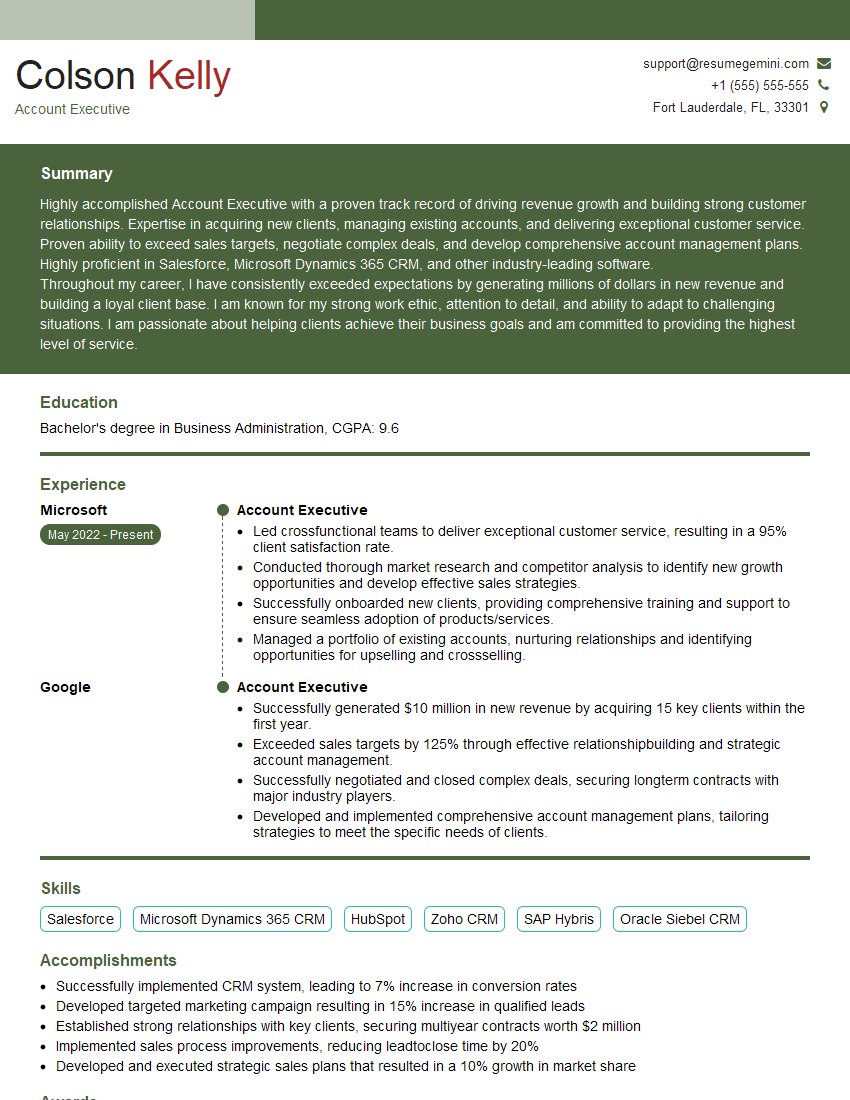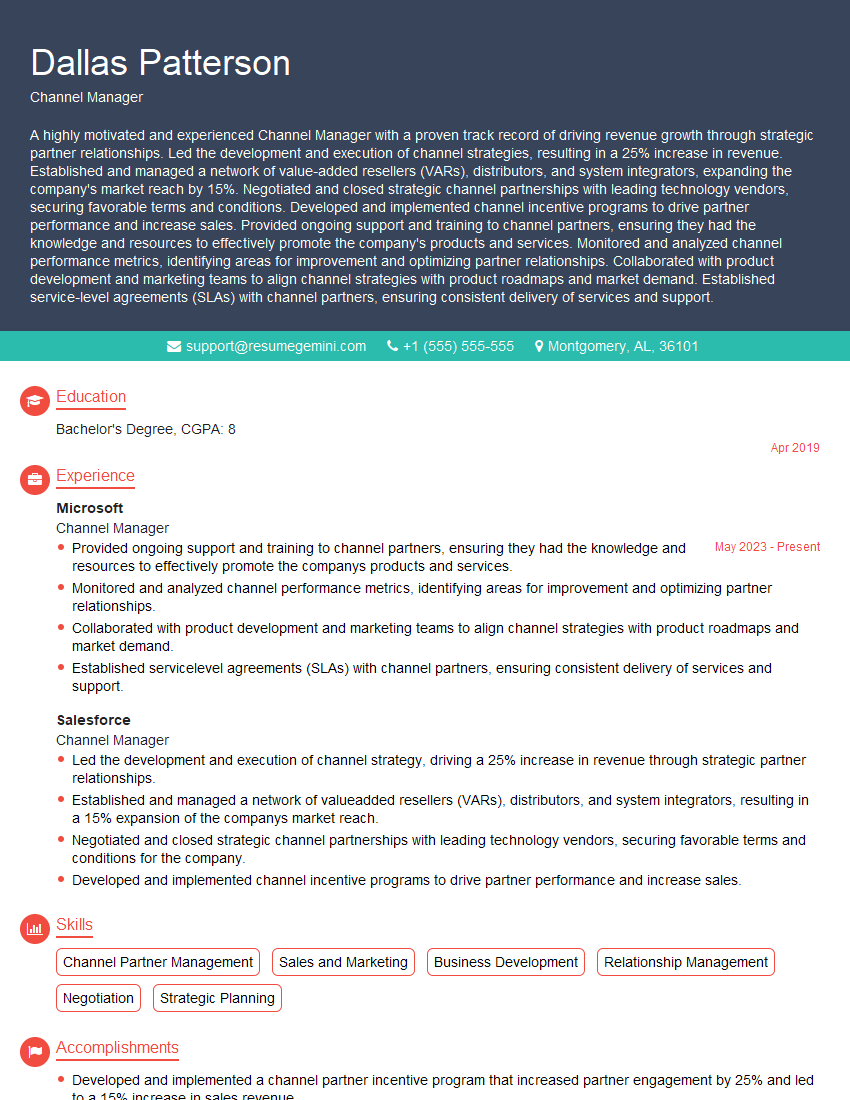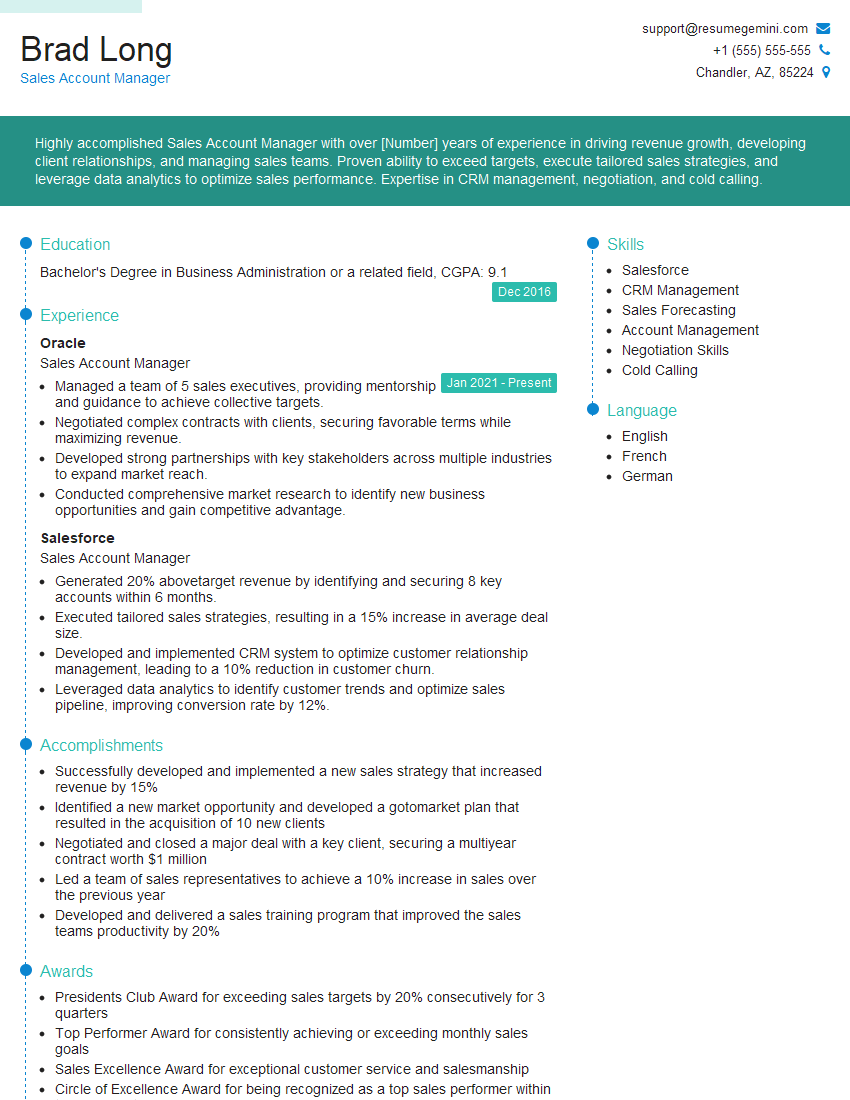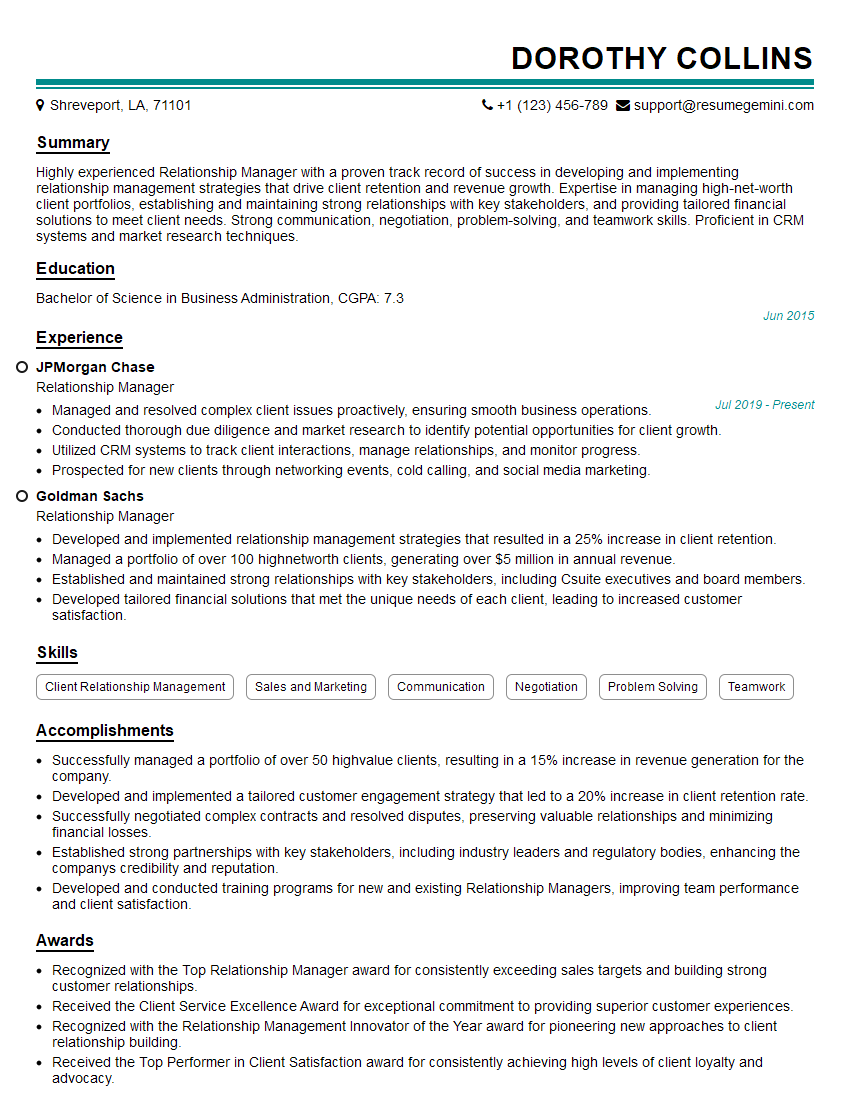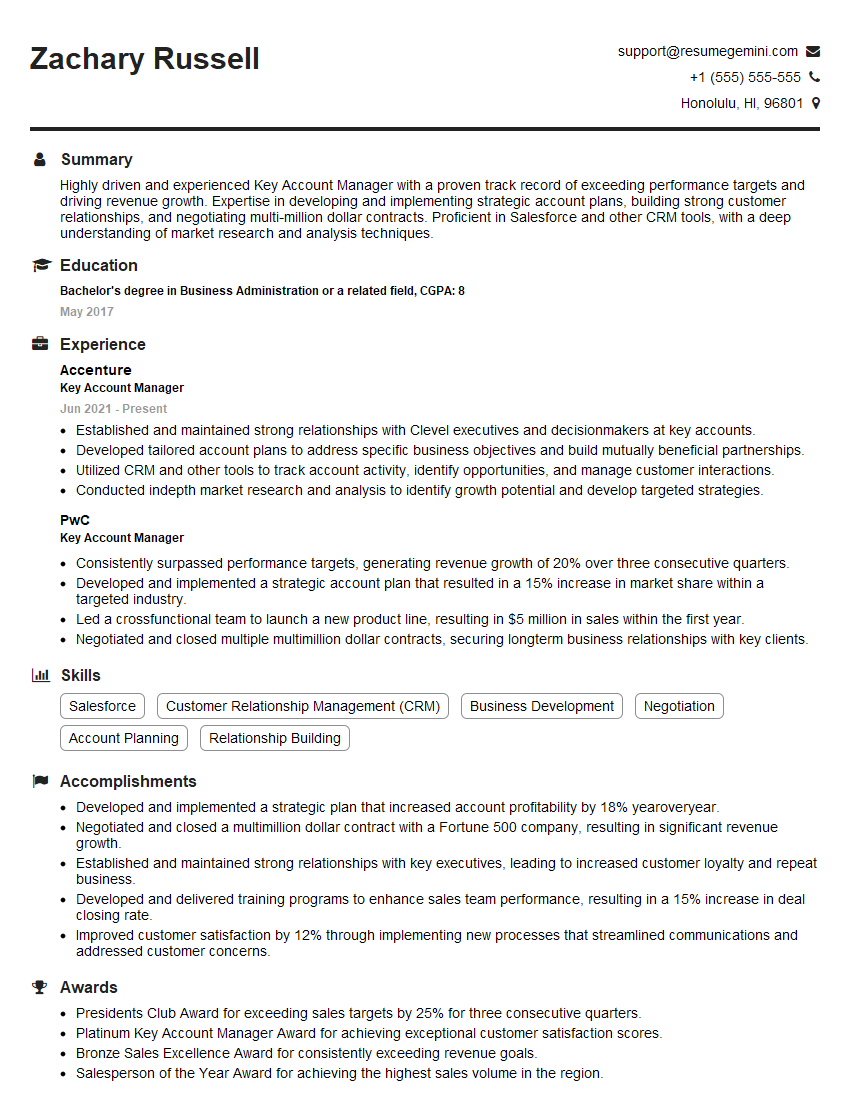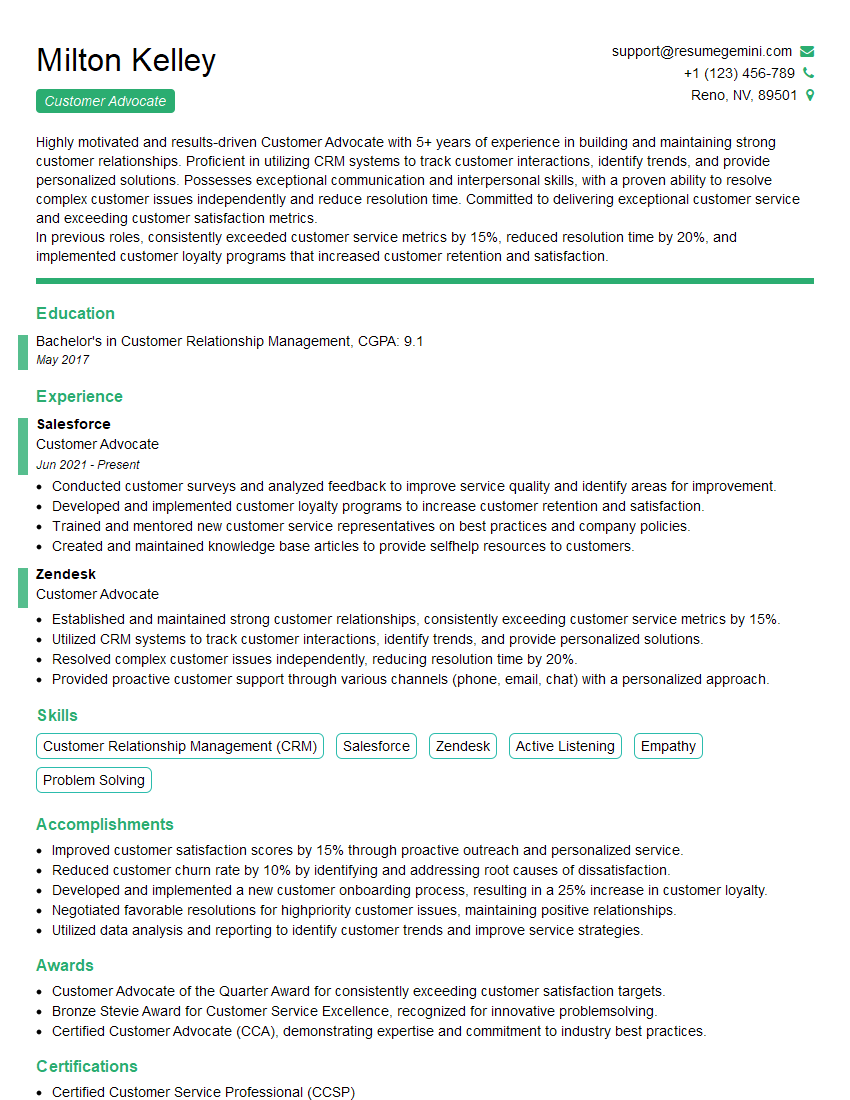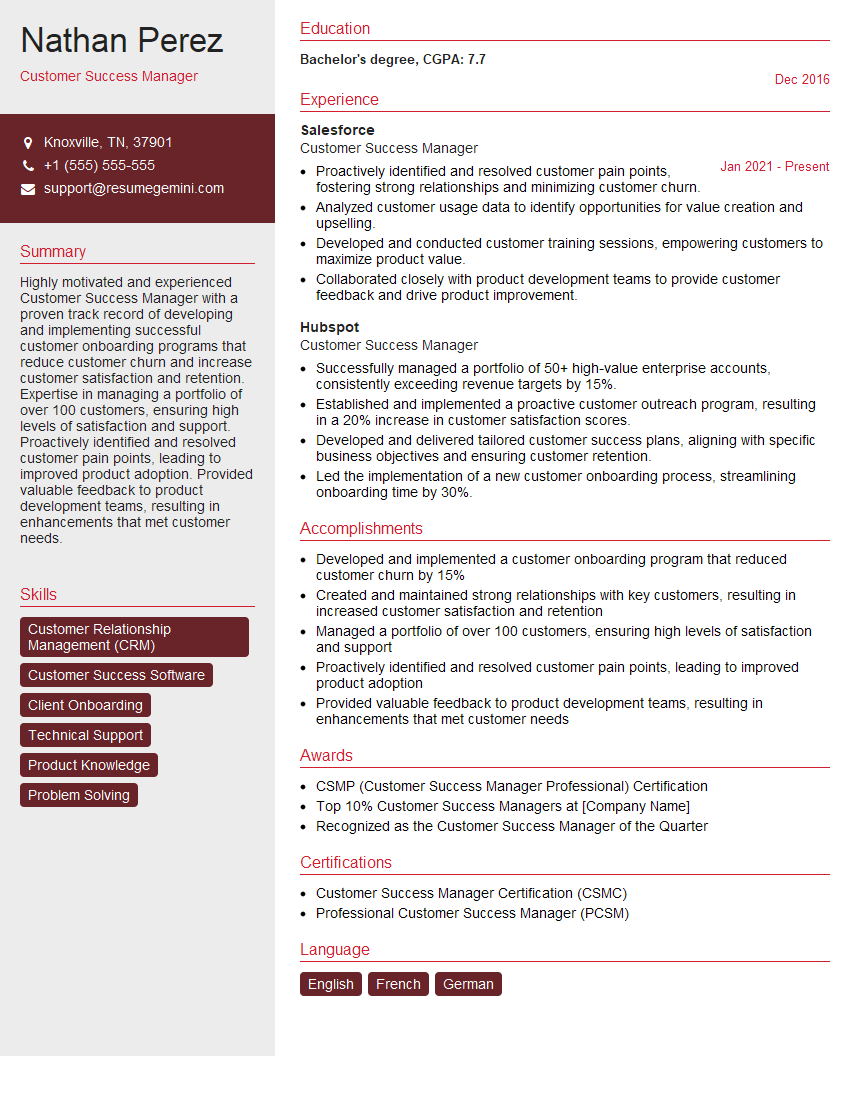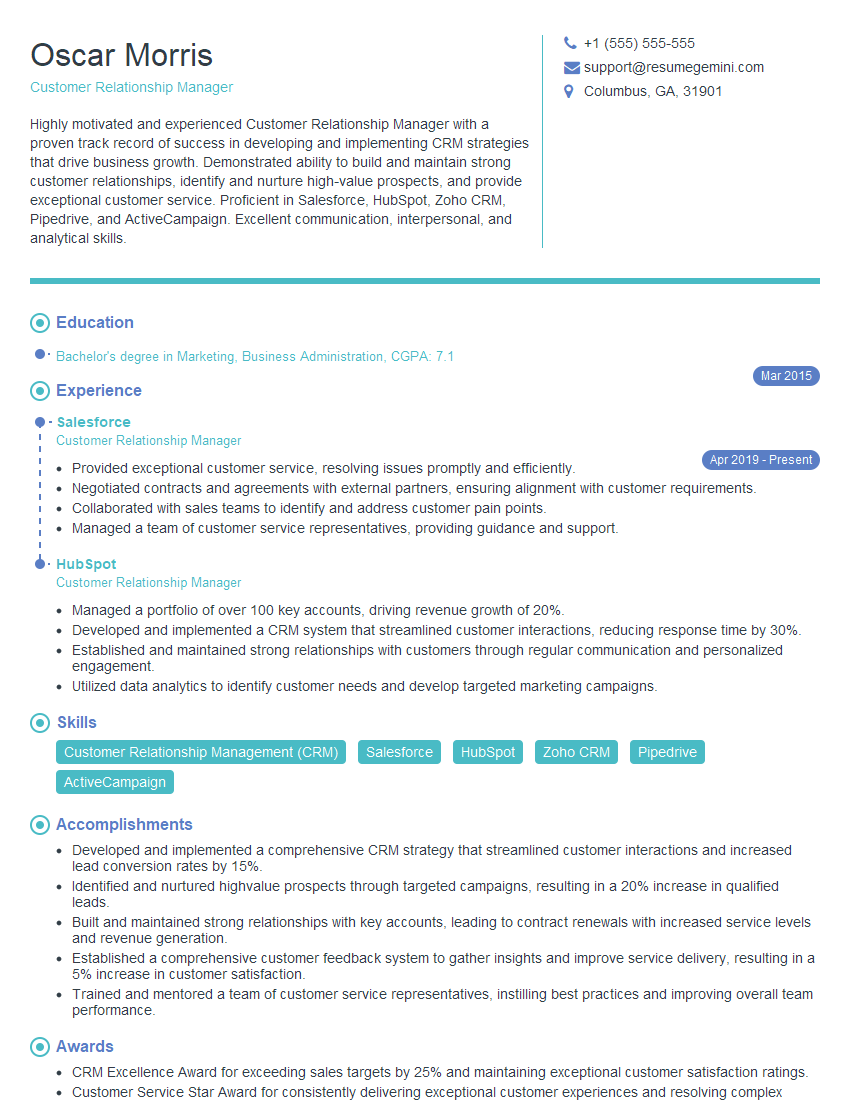The thought of an interview can be nerve-wracking, but the right preparation can make all the difference. Explore this comprehensive guide to Experience in Client Relationship Management interview questions and gain the confidence you need to showcase your abilities and secure the role.
Questions Asked in Experience in Client Relationship Management Interview
Q 1. Describe your experience building and maintaining strong client relationships.
Building and maintaining strong client relationships is the cornerstone of successful business. It’s about fostering trust, understanding, and mutual respect. My approach involves a multi-faceted strategy focusing on proactive communication, personalized service, and consistent follow-up.
Proactive Communication: I believe in regular check-ins, not just when there’s a problem. I schedule regular calls or meetings to discuss progress, address concerns proactively, and simply maintain an open dialogue. This helps prevent misunderstandings and fosters a sense of partnership.
Personalized Service: I strive to understand each client’s unique business goals and challenges. This means taking the time to listen, ask insightful questions, and tailor my approach to their specific needs. For instance, I once learned a client’s company was celebrating its 20th anniversary. I incorporated that into our next communication, showing I valued their history and wasn’t just focused on the transactional aspect of our relationship.
Consistent Follow-Up: Following up promptly on requests, emails, and promises is crucial. This demonstrates reliability and shows the client that their time and concerns are valued. I utilize a CRM system to ensure I never miss a deadline or a follow-up task.
Q 2. How do you identify and prioritize client needs?
Identifying and prioritizing client needs is an iterative process that requires active listening and keen observation. I use a combination of methods to understand their requirements:
Active Listening during Meetings and Calls: I pay close attention not only to what clients say, but also to their tone and body language. This helps identify underlying concerns or unspoken needs.
Regular Feedback Surveys and Questionnaires: These tools provide valuable insights into client satisfaction and identify areas for improvement. I design these to be concise and focused on specific aspects of our service.
Analyzing Client Data: Using CRM data like interaction history, transaction details, and support tickets, I can identify patterns and trends indicating recurring needs or pain points.
Prioritization: Once needs are identified, I prioritize them based on urgency, impact, and alignment with the client’s overall business goals. I often use a matrix that weighs these factors to make informed decisions about resource allocation.
Q 3. Explain your approach to managing client expectations.
Managing client expectations is crucial for building trust and preventing misunderstandings. My approach involves clear, upfront communication and realistic goal setting.
Setting Clear Expectations from the Start: I clearly outline the scope of work, deliverables, timelines, and potential challenges in a formal agreement or project plan. This ensures everyone is on the same page from the outset.
Regular Progress Updates: I provide regular updates, both verbally and in writing, to keep clients informed of progress and address any emerging concerns. This transparency helps prevent surprises and maintains alignment.
Being Realistic: I avoid making unrealistic promises. Instead, I focus on providing achievable solutions and clearly communicate any potential roadblocks or limitations.
Proactive Communication of Changes: If unforeseen circumstances arise that impact the project, I communicate proactively to adjust expectations and seek solutions collaboratively.
Q 4. How do you handle difficult or challenging clients?
Handling difficult or challenging clients requires empathy, patience, and a proactive approach. My strategy involves active listening, finding common ground, and focusing on solutions.
Active Listening and Empathy: I start by actively listening to the client’s concerns, validating their feelings, and understanding their perspective, even if I don’t necessarily agree. This shows respect and helps de-escalate the situation.
Finding Common Ground: I look for areas of agreement and focus on shared goals. This helps build a collaborative relationship, even in challenging situations.
Problem-Solving: I work collaboratively with the client to identify the root cause of the problem and develop mutually acceptable solutions. I present options clearly and explain the rationale behind my recommendations.
Escalation Protocol: In cases where I cannot resolve the issue myself, I have a clear escalation protocol in place to involve the appropriate internal resources.
Q 5. Describe a time you exceeded client expectations. What was your strategy?
In a previous role, a client was facing a critical deadline for a major product launch. Their existing system was experiencing unexpected performance issues, threatening the launch date. I went beyond my typical responsibilities to exceed their expectations.
Strategy: I assembled a cross-functional team, including engineers and project managers, to work around the clock. We implemented a temporary workaround to stabilize the system and simultaneously developed a longer-term solution. I also proactively communicated updates every few hours, keeping the client informed of our progress.
Outcome: Not only did we meet the deadline, but we also delivered a more robust and stable system than initially planned. The client was extremely grateful for our dedication and proactive problem-solving, resulting in a strengthened relationship and several referrals.
Q 6. How do you measure the success of your client relationships?
Measuring the success of client relationships involves a combination of qualitative and quantitative measures. I use several key indicators:
Client Satisfaction Surveys: Regular feedback surveys provide valuable insights into client happiness and areas for improvement.
Net Promoter Score (NPS): This metric measures client loyalty and willingness to recommend our services.
Client Retention Rate: A high retention rate indicates strong client relationships and satisfaction.
Revenue Growth from Existing Clients: Increased revenue from existing clients demonstrates the effectiveness of our relationship-building efforts.
Positive Testimonials and Referrals: These are powerful indicators of client satisfaction and trust.
Q 7. What CRM software are you proficient in?
I am proficient in several CRM software applications, including Salesforce, HubSpot, and Zoho CRM. My experience with these platforms extends beyond basic data entry; I’m skilled in configuring custom fields, building reports and dashboards, and automating workflows to enhance efficiency and streamline client interactions. For example, I’ve used Salesforce’s automation features to create personalized email sequences for onboarding new clients and to trigger automated reminders for follow-up tasks. This level of proficiency ensures data integrity, efficient communication, and proactive client management.
Q 8. How do you manage multiple client accounts simultaneously?
Managing multiple client accounts effectively requires a structured approach. Think of it like juggling – each client is a ball, and you need to keep them all in the air without dropping any. I utilize a combination of tools and strategies to ensure success. Firstly, I leverage a robust CRM (Customer Relationship Management) system to track all client interactions, deadlines, and project details. This central hub allows me to see at a glance the status of each account and prioritize tasks effectively. Secondly, I prioritize tasks based on urgency and importance, using methods like Eisenhower Matrix (urgent/important) to determine which clients require immediate attention. Finally, I schedule dedicated time blocks for specific clients or tasks, minimizing context switching and maximizing focus. For example, I might dedicate Monday mornings to strategic planning for client A, while Tuesday afternoons are reserved for client B’s ongoing projects. This prevents feeling overwhelmed and ensures consistent, high-quality service to all clients.
Q 9. How do you stay organized and manage your time effectively?
Staying organized and managing time effectively is paramount. My approach is multifaceted. I begin with meticulous planning. I use a digital calendar and task management system to schedule appointments, set deadlines, and track progress. I break down large tasks into smaller, manageable steps, making them less daunting and easier to track. Time blocking, as mentioned earlier, is crucial. I allocate specific time slots for different activities, including client communication, project work, and administrative tasks. Regular review is key – I set aside time each week to review my schedule, prioritize tasks, and adjust my plan as needed. This helps prevent unforeseen issues from derailing my schedule. Finally, I utilize productivity techniques like the Pomodoro Technique (working in focused bursts with short breaks) to maintain concentration and avoid burnout. This ensures efficiency and prevents feeling overwhelmed.
Q 10. Describe your process for onboarding new clients.
My client onboarding process is designed to be thorough and efficient. It begins with a detailed kickoff meeting where I gather all necessary information about the client’s needs and expectations. This includes understanding their business goals, current processes, and desired outcomes. Next, I create a personalized onboarding plan outlining key milestones and deliverables, ensuring transparency and clear expectations. We establish communication protocols, defining preferred methods and response times. This phase also includes a comprehensive training session to familiarize the client with the services we provide. Following this, we set up regular check-in meetings to monitor progress and address any arising questions or concerns. For instance, with a new marketing client, I might provide a detailed presentation of our strategies, followed by a setup call to walk them through the online dashboards and report access. This detailed and structured approach ensures a smooth transition and a strong foundation for a successful working relationship.
Q 11. How do you identify and address potential client issues proactively?
Proactive issue identification is crucial for maintaining strong client relationships. I achieve this through regular communication, close monitoring of key performance indicators (KPIs), and actively seeking client feedback. For example, I might schedule regular check-in calls to discuss ongoing projects, solicit feedback on our performance, and proactively address any potential concerns. Regular reviews of client data also allow me to identify potential problems early on, such as a drop in engagement or a dip in sales. By addressing issues before they escalate, we prevent larger problems and demonstrate our commitment to client success. A key strategy is to actively listen to clients, pay attention to subtle cues, and interpret data trends to identify emerging risks.
Q 12. How do you handle client complaints effectively?
Handling client complaints effectively requires empathy, professionalism, and a solution-oriented approach. My process begins with actively listening to the client’s concerns without interruption. I aim to understand their perspective and validate their feelings. Next, I apologize sincerely for any inconvenience or frustration caused, regardless of who is at fault. Then, I work collaboratively with the client to find a resolution. This might involve offering a refund, making amends, or implementing corrective actions. Finally, I follow up with the client to ensure their satisfaction and prevent future occurrences. For instance, if a client complains about a delay in a project, I would first apologize, explain the reasons for the delay, and propose a revised timeline with concrete steps to ensure timely completion. Transparency and a commitment to resolving the issue are paramount.
Q 13. How do you build rapport with clients?
Building rapport with clients is about establishing trust and a strong working relationship. It starts with active listening and demonstrating genuine interest in their business and goals. I strive to understand their unique needs and challenges, tailoring my approach to each individual client. I make a point of remembering personal details, showing that I value them as individuals, not just accounts. Regular communication, including both formal updates and informal check-ins, helps maintain a strong connection. Showing appreciation for their business and acknowledging their contributions reinforces the positive relationship. Building rapport is an ongoing process, requiring consistent effort and genuine care. For example, remembering a client’s family situation or a significant project milestone can go a long way in building a strong and lasting relationship.
Q 14. Describe your experience with client communication strategies.
My client communication strategies are diverse and tailored to the individual client’s preferences and the context of the communication. I utilize a multi-channel approach, employing email, phone calls, video conferencing, and project management software as needed. For routine updates, email is efficient, while urgent matters require a phone call or video conference. I strive for clear, concise, and timely communication, ensuring that messages are easily understood and actionable. I also prioritize active listening and feedback mechanisms to ensure mutual understanding. Depending on the client’s communication style and preferences, I might adapt my style to match, maintaining a consistent and personalized approach. For instance, a busy CEO might prefer concise email updates, while a smaller business owner might prefer more detailed phone calls.
Q 15. How do you adapt your communication style to different clients?
Adapting my communication style is crucial for effective client relationship management. I believe in tailoring my approach to each client’s personality, communication preferences, and the context of our interaction. I start by actively listening and observing – understanding their communication style helps me mirror it to build rapport. For example, with a client who is direct and to-the-point, I’ll use concise and factual language, avoiding unnecessary details. Conversely, with a client who appreciates a more collaborative approach, I will involve them in decision-making processes, fostering a sense of partnership. In addition to verbal communication, I adapt my written communication as well, ranging from formal emails for official correspondence to informal messages for quick updates, depending on the client’s preference and the situation.
Think of it like this: a gardener wouldn’t use the same tools and techniques for cultivating a rose bush as they would for a hardy oak tree. Similarly, I adjust my communication approach based on the unique needs of each client.
Career Expert Tips:
- Ace those interviews! Prepare effectively by reviewing the Top 50 Most Common Interview Questions on ResumeGemini.
- Navigate your job search with confidence! Explore a wide range of Career Tips on ResumeGemini. Learn about common challenges and recommendations to overcome them.
- Craft the perfect resume! Master the Art of Resume Writing with ResumeGemini’s guide. Showcase your unique qualifications and achievements effectively.
- Don’t miss out on holiday savings! Build your dream resume with ResumeGemini’s ATS optimized templates.
Q 16. How do you utilize client feedback to improve service?
Client feedback is invaluable for service improvement. I actively solicit feedback through various channels, including post-project surveys, regular check-in calls, and informal conversations. I analyze this feedback systematically, identifying recurring themes and areas for improvement. This might involve identifying process inefficiencies, skill gaps within the team, or even areas where our communication could be enhanced.
For instance, if multiple clients mention difficulty navigating our online portal, I’d advocate for a redesign or improved user training. If feedback highlights a lack of responsiveness, I’d work with my team to establish clearer communication protocols and better allocation of resources. This iterative process of collecting, analyzing, and acting on feedback is key to continuously improving the client experience and fostering long-term relationships.
Q 17. Explain your understanding of the client lifecycle.
The client lifecycle is a crucial framework in CRM. It represents the journey a client takes from initial contact to eventual termination of the relationship (although ideally, we aim for long-term partnerships). It typically encompasses several stages:
- Prospecting/Lead Generation: Identifying and qualifying potential clients.
- Acquisition/Onboarding: Winning new clients and integrating them into our systems and processes.
- Relationship Building/Growth: Developing strong relationships, understanding needs, and expanding the scope of services.
- Retention/Loyalty: Maintaining client relationships and preventing churn.
- Termination/Win-back: Handling client exits and, if possible, attempting to re-engage lost clients.
Understanding each stage allows me to anticipate client needs, proactively address potential challenges, and tailor our interactions for maximum impact at each point in the journey. For example, during the onboarding phase, I focus on clear communication and efficient setup. During retention, I prioritize regular check-ins and value-added services to maintain engagement.
Q 18. Describe your experience working with cross-functional teams to serve clients.
Collaboration is critical for successful client service. I have extensive experience working with cross-functional teams, including marketing, technical support, and product development, to deliver comprehensive solutions for our clients. I act as a central point of contact, ensuring clear communication and coordination between different teams. This requires strong communication, active listening, and conflict-resolution skills. I make sure everyone understands the client’s needs and expectations, ensuring alignment on objectives and timelines. I facilitate regular team meetings to track progress, address challenges, and ensure seamless execution. This collaborative approach fosters a sense of shared responsibility and maximizes the value delivered to the client.
For example, in a recent project, I worked with marketing to develop targeted content for a client campaign, with the technical team to ensure seamless system integration, and with product development to incorporate client-specific features. This collaborative effort resulted in a highly successful project that exceeded client expectations.
Q 19. How do you contribute to client retention efforts?
Client retention is a top priority. My contributions focus on building strong relationships, exceeding expectations, and proactively addressing potential issues. This involves:
- Regular communication: Maintaining consistent contact to stay informed about client needs and providing updates on our progress.
- Proactive problem-solving: Identifying and addressing potential issues before they escalate into major problems.
- Value-added services: Offering extra services or support to demonstrate our commitment to their success.
- Feedback loops: Actively seeking client feedback and using it to improve our services.
- Relationship building: Developing personal connections and fostering trust with our clients.
By fostering loyalty and a strong sense of partnership, we significantly reduce client churn and build a foundation for long-term success.
Q 20. Describe a time you had to negotiate with a client. What was the outcome?
I once had to negotiate a revised scope of work with a client who wanted additional features added to their project midway through. They felt these additions were critical to their business goals, but it would increase the cost and timeline. My approach involved first actively listening to their concerns and understanding the value these features would provide. Then, I presented a detailed proposal outlining the impact of the changes on the project budget and timeline, clearly outlining the additional costs and potential delays. We explored alternative solutions, including prioritizing certain features to minimize the impact on the timeline and finding areas where we could streamline the project to partially offset the increased costs.
Ultimately, we reached a mutually agreeable compromise where the client accepted a phased approach, prioritizing the most crucial features and deferring others to a later phase. This ensured we met their key business needs while managing the project effectively. The outcome was a successful project completion, strengthened client relations, and a template for future negotiations involving scope changes.
Q 21. How do you stay up-to-date on industry trends and best practices?
Staying current with industry trends and best practices is crucial in CRM. I utilize several methods to achieve this:
- Industry publications and journals: I regularly read publications such as Harvard Business Review and other relevant journals focused on sales, marketing and customer relationship management.
- Conferences and webinars: Attending industry conferences and webinars offers valuable insights from leading experts and provides opportunities to network with peers.
- Professional development courses: I regularly participate in online courses and workshops on CRM strategies, sales techniques, and customer service best practices.
- Networking: Connecting with colleagues through professional organizations and online communities fosters knowledge sharing and exposes me to diverse perspectives.
- Client interaction: Directly learning from clients’ needs and challenges provides invaluable real-world insights.
By consistently seeking out and applying this knowledge, I continuously refine my approach, maximizing the effectiveness of my client relationships.
Q 22. How would you approach a client who is consistently unhappy?
Addressing consistent client unhappiness requires a proactive and empathetic approach. It’s not about quick fixes, but about understanding the root cause and building a path to resolution. My strategy involves several key steps:
- Active Listening and Empathy: I begin by actively listening to the client’s concerns without interruption. This demonstrates respect and helps me understand their perspective. I use empathetic phrases like, “I understand your frustration,” to build rapport.
- Identifying the Root Cause: Once I understand their concerns, I delve deeper to uncover the underlying issue. Is it a product defect? Poor service? Miscommunication? Asking clarifying questions is crucial here. For example, instead of simply asking, “What’s wrong?”, I’d ask, “Can you describe the specific instances where you felt dissatisfied?”
- Proposing Solutions and Setting Expectations: Based on the root cause, I propose concrete solutions, outlining realistic timelines and expectations. Transparency is key – I’ll communicate potential challenges and involve the client in the solution-finding process.
- Following Up and Monitoring: After implementing solutions, I follow up regularly to ensure the client is satisfied. This proactive approach builds trust and demonstrates commitment to their success. I would also ask for feedback on the process and the solution itself.
For example, I once worked with a client whose project was consistently delayed due to internal miscommunication. By implementing a clear communication plan with regular check-ins, and assigning a dedicated point of contact, we managed to regain their trust and successfully complete the project.
Q 23. What is your experience with contract negotiations and renewals?
Contract negotiations and renewals are a critical part of client relationship management. My experience encompasses all phases, from initial review to final agreement and beyond. I approach negotiations strategically, focusing on mutual benefit and long-term partnerships.
- Understanding Client Needs: Before entering negotiations, I thoroughly understand the client’s business goals and challenges. This allows me to tailor the contract to meet their specific requirements and demonstrate value.
- Strategic Planning: I develop a negotiation strategy that outlines key objectives, potential concessions, and alternative solutions. This ensures I’m prepared for any scenario.
- Effective Communication: Clear and concise communication throughout the negotiation process is essential. I strive to build a collaborative environment where both parties feel heard and understood.
- Risk Management: I identify and mitigate potential risks associated with the contract, such as unforeseen circumstances or liability issues. This includes careful review of legal and financial clauses.
- Renewal Strategies: For renewals, I analyze the client’s usage patterns, satisfaction levels, and evolving needs. This information informs negotiations and allows me to propose customized solutions to ensure continued partnership.
In one instance, I successfully negotiated a contract renewal with a key client by proactively addressing their concerns about pricing and service delivery. By proposing a customized service package and flexible payment options, I secured a long-term agreement that benefited both parties.
Q 24. How do you use data and analytics to inform your client relationship strategy?
Data and analytics are fundamental to a successful client relationship strategy. They allow for data-driven decision-making, resulting in more effective and personalized interactions. I leverage data in several ways:
- Client Segmentation: I use data to segment clients based on their behavior, needs, and value. This allows for targeted communication and customized solutions.
- Performance Monitoring: I track key metrics like customer satisfaction, retention rate, and revenue generated per client. This helps identify areas for improvement and measure the success of our strategies.
- Predictive Analytics: By analyzing historical data, I can predict potential issues and proactively address them. For example, I can identify clients at risk of churn and intervene to retain them.
- Personalized Communication: Data allows me to personalize communication and tailor offerings to individual client needs. This improves engagement and builds stronger relationships.
For example, by analyzing customer support tickets and surveys, I identified a recurring issue with a particular product feature. This insight enabled us to prioritize improvements and enhance customer satisfaction significantly.
Q 25. Describe your experience with building and maintaining client trust.
Building and maintaining client trust is paramount. It’s the cornerstone of any successful long-term relationship. My approach focuses on consistency, transparency, and accountability:
- Consistent Communication: I maintain regular contact with clients, providing timely updates and proactively addressing any concerns. This consistent communication builds familiarity and confidence.
- Transparency and Honesty: I’m always upfront and honest with clients, even when delivering difficult news. Transparency fosters trust and builds credibility.
- Accountability: I take ownership of my actions and commitments. If something goes wrong, I take responsibility and work diligently to rectify the situation. This demonstrates reliability and integrity.
- Exceeding Expectations: I consistently strive to exceed client expectations, going the extra mile to deliver exceptional service. This builds loyalty and strengthens the client-relationship.
In a previous role, I helped a client navigate a complex regulatory change. By communicating transparently throughout the process and proactively anticipating challenges, I gained their trust and secured their continued business.
Q 26. How do you identify opportunities for upselling or cross-selling to existing clients?
Identifying upselling and cross-selling opportunities requires a deep understanding of the client’s needs and our product/service portfolio. I approach this strategically:
- Regular Client Reviews: I schedule regular reviews with clients to discuss their current needs and explore potential areas for expansion or improvement.
- Needs Analysis: During these reviews, I actively listen to understand their evolving business goals and identify any gaps in their current solutions. This is not a hard sell; it’s about understanding.
- Value Proposition: I present relevant upselling or cross-selling opportunities, focusing on the value they’ll bring to the client’s business. This is about demonstrating ROI, not just pushing products.
- Tailored Solutions: I develop customized solutions that meet the client’s specific needs, avoiding a “one-size-fits-all” approach.
For instance, a client initially subscribed to our basic software package. Through regular review meetings, I discovered their expanding team required more advanced features. I presented the premium package, highlighting the increased efficiency and cost savings, and they upgraded successfully.
Q 27. How do you handle confidential client information?
Confidentiality is paramount in client relationship management. I adhere to strict protocols to safeguard sensitive information. My approach includes:
- Compliance with Regulations: I’m fully compliant with all relevant data privacy regulations, such as GDPR and CCPA. I understand the legal requirements for handling client data.
- Secure Data Handling: I use secure systems and protocols to store and transmit client information, including encryption and access controls.
- Data Minimization: I only collect and retain the minimum necessary client data, reducing the risk of unauthorized access or breaches.
- Access Restrictions: I ensure that access to client data is restricted to authorized personnel only, using role-based access controls.
- Incident Response Plan: I am familiar with the company’s data breach response plan and know how to react appropriately in case of a security incident.
I’ve always treated confidential client information with the utmost care and respect, understanding that trust is built on the assurance that sensitive data is handled responsibly and securely.
Q 28. What are your salary expectations for this role?
My salary expectations are commensurate with my experience and the requirements of this role. I’ve researched industry standards for similar positions and am confident in stating my desired salary range of [Insert Salary Range Here]. However, I am open to discussing this further, considering the full compensation package and long-term growth opportunities within the company.
Key Topics to Learn for Your Client Relationship Management Interview
- Building Rapport and Trust: Explore effective communication techniques, active listening skills, and strategies for understanding client needs and motivations. Consider how to adapt your approach to different personality types.
- Needs Assessment and Solution Development: Practice identifying client needs through insightful questioning and analysis. Learn how to translate those needs into tailored solutions and demonstrate your problem-solving capabilities in a client-focused context.
- Conflict Resolution and Negotiation: Understand various conflict resolution strategies and how to navigate difficult conversations with clients. Practice techniques for finding mutually beneficial solutions during negotiations.
- Client Retention and Account Management: Discuss strategies for maintaining long-term client relationships, proactively addressing concerns, and identifying opportunities for growth within existing accounts. Showcase your ability to manage a portfolio of clients effectively.
- CRM Software and Technology: Demonstrate familiarity with common CRM platforms and their applications in managing client interactions, tracking progress, and analyzing data to improve client service.
- Communication and Reporting: Practice preparing clear and concise reports to update clients on progress, address concerns, and highlight successes. Demonstrate your ability to tailor communication style to different stakeholders.
- Ethical Considerations and Professionalism: Highlight your understanding of ethical considerations in client interactions, data privacy, and maintaining professional conduct at all times.
Next Steps
Mastering Client Relationship Management is crucial for career advancement in many fields. Proficiency in this area demonstrates valuable skills highly sought after by employers, opening doors to leadership roles and increased earning potential. To maximize your job prospects, creating an ATS-friendly resume is essential. This ensures your application gets noticed by recruiters and hiring managers. We strongly recommend using ResumeGemini, a trusted resource, to build a professional and impactful resume that highlights your CRM expertise. Examples of resumes tailored to Client Relationship Management experience are available to guide you.
Explore more articles
Users Rating of Our Blogs
Share Your Experience
We value your feedback! Please rate our content and share your thoughts (optional).
What Readers Say About Our Blog
Hello,
We found issues with your domain’s email setup that may be sending your messages to spam or blocking them completely. InboxShield Mini shows you how to fix it in minutes — no tech skills required.
Scan your domain now for details: https://inboxshield-mini.com/
— Adam @ InboxShield Mini
Reply STOP to unsubscribe
Hi, are you owner of interviewgemini.com? What if I told you I could help you find extra time in your schedule, reconnect with leads you didn’t even realize you missed, and bring in more “I want to work with you” conversations, without increasing your ad spend or hiring a full-time employee?
All with a flexible, budget-friendly service that could easily pay for itself. Sounds good?
Would it be nice to jump on a quick 10-minute call so I can show you exactly how we make this work?
Best,
Hapei
Marketing Director
Hey, I know you’re the owner of interviewgemini.com. I’ll be quick.
Fundraising for your business is tough and time-consuming. We make it easier by guaranteeing two private investor meetings each month, for six months. No demos, no pitch events – just direct introductions to active investors matched to your startup.
If youR17;re raising, this could help you build real momentum. Want me to send more info?
Hi, I represent an SEO company that specialises in getting you AI citations and higher rankings on Google. I’d like to offer you a 100% free SEO audit for your website. Would you be interested?
Hi, I represent an SEO company that specialises in getting you AI citations and higher rankings on Google. I’d like to offer you a 100% free SEO audit for your website. Would you be interested?
good
